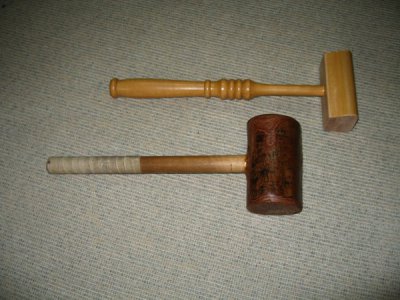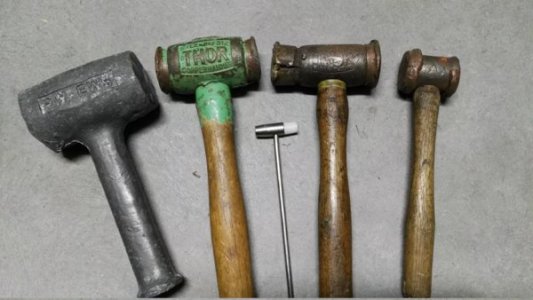A philisophical point, to me, on the use of "dead blow" hammers: I personally don't use 'em. at all. If something has to be hit hard enough to bounce the hammer, take a second look at what is being hit, You wouldn't use a tack hammer on a bulldozer and wouldn't use a 15 pound sledge on a watch. Each one has it's uses and purposes. I use lead in the machine shop, rawhide in the electric shop (copper windings) and brass for my models. The hammer has to be heavy enough to move your work alone. If you have to swing hard enough for the hammer to bounce, the hammer's too small.
Lead is my most frequently used. I cast a new one every few months, with a piece of EMT for a handle. For a fairly big one, a (12 oz) soda can (or beer can) makes a good mold. For the bench size, I use a toilet paper roller wrapped with sheet metal to hold its round shape while I pour the lead. Half to three quarters full makes a good size for general bench use. Brass is shaped as needed on the lathe and a handle put in. I prefer a hickory handle, but that's just me being an old timer. A well shaped metal handle works just as well.
I have a twenty-five pound sledge ("millwright's" hammer), a "B&O" of some 12 pounds after I cut down the punch, and a railroad spike hammer (a "steepnose"?) of about the same weight. And a couple dozen of a lesser size. The big issue is that sometimes you want the hammer harder so it will stand up, such as the spike hammer. And sometimes softer than what you're shoving into place. Such as a joiner's wooden mallet. And the occasional oddball such as a leather hammer for motor windings and hard rubber for thin sheet matal.
With time, hammers are a personal taste issue, depending as much on background as anything. If you use a steel hammer to move a piece of soft metal on a machine, never hit it hard enough to leave a mark or a dent. That's where all those odd metals come in, each softer than the work it's used for. As often as not, a large chunk of copper, brass, aluminium, wood, plastic, or whatever can serve the purpose just as well. You shape it into a hammer about the third time you use it.



